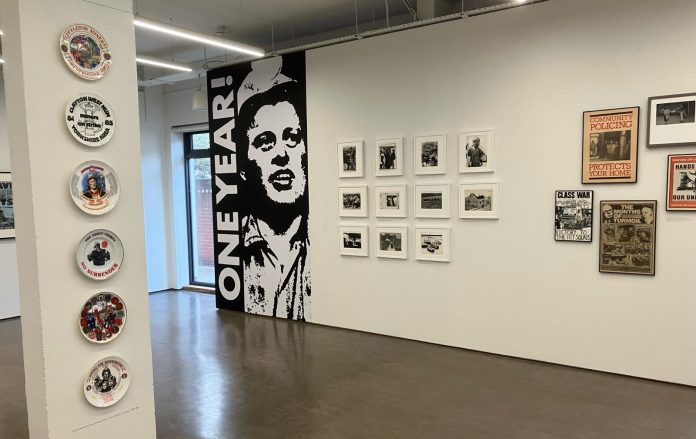Martin Parr Foundation exhibition: One Year! Photographs from the miners’ strike 1984-85
Featuring works by: John Harris, Chris Killip, Jenny Matthews, Brenda Prince, Neville Payne, Howard Sooley, John Sturrock, Roger Tiley, Philip Winnard and Imogen Young
Reviewed by Roger Thomas

For the 40th anniversary of the miners’ strike, the Martin Parr foundation in Bristol, has hosted an exhibition that looks at the pivotal role photography played in the year-long dispute.
The exhibition looks at the images created and how they were used and disseminated through the visual media of the time. While one side sought to use these images to highlight the chaos on picket lines and to heighten the image of an enemy within, those in support of the strike attempted to undermine this picture, highlighting instead the violence of the state on picket lines, the economic hardship endured, and especially the solidarity and collective strength of a working-class community under siege.
Many of the images show the solidarity between the community and the miners’ union, NUM, spreading out across the country, in the collection of food and funds, and many of the objects – from plates and badges to records – give an indication as to just how disparate the use of different media was for this purpose. As well as posters, postcards and leaflets advertising gigs and comedy nights – using satire, and anti-government language to build solidarity.
One of the images included is of Alan Hardman’s cartoon of the miner and his son. Others feature the multiple representation in different media of John Harris’s iconic image from Orgreave depicting a police officer swinging his truncheon from his horse at Lesley Boulton, of Women Against Pit Closures: an image which clearly expresses the violence of that day inflicted on the miners and their supporters.
The photographs of Brenda Prince focus on depictions of women in the Nottinghamshire coalfield, picketing and fundraising. She highlights the politicising role of the strike, writing in the programme notes: “Women became more confident as a result of strike, which I thought was great. It was good for other women and young girls to see their mums and daughters speaking out at the meetings, doing things they wouldn’t have done before, eg picketing”.
There are several scenes expressing the humanity of the strike which so captured the imaginations of photo-journalists, many of them using their position to champion the miners’ cause. John Harris and John Sturrock focus primarily on the day-to-day activities from picketing, to union meetings and coal riddling. Such events, mundane in themselves, and making up the majority of a day on the picket line, are punctuated by police violence administered without any compunction in mismatched confrontations on picket lines.
John Sturrock covered the strike from day one and the exhibition features compelling images from pits in Cortonwood, to Bilston Glen, and down to Didcot. One compelling image is of the march on the anniversary of the death of miner David Jones, killed whilst picketing at the start of the strike: miners marching in a snowstorm. Another gripping image is John Harris’s picture of a police charge at the Battle of Orgreave which exudes the tension of that grim moment in the strike.
A more intimate view of the strikes comes through the albums of Philip Winnard, himself a striking miner. These pictures have a certain rawness and his photographs of scabs loading coal to break the strike are contemptuous and lay those individuals bare. Similar feelings are evoked by snapshots of police picnicking between breaking the strike. There is a real sense of unreality about these photos.
There is one exhibit which is not of 1984-85, that is the textile created by Jenny Matthews, who during Covid began revisiting her photo archive, using the tactile nature of embroidery to weave a photo-quilt, which evokes the idea of images of the miners’ strike with the traditional union banner.
The exhibition clearly expresses the power of photography to capture the moment and the power and tensions at play. But I think this and similar exhibitions that will undoubtedly take place across the country give us an opportunity to reconnect with what was, and still is, a life-changing event, which still sits deep in the collective consciousness. However, I also think these photographs do much more: they expose the nature of the state and the lengths the ruling class will go to defend itself, while also expressing the solidarity and determination of the working class to struggle.







